Small and Rural Critical Access Hospitals (Slide Presentation)
On the CUSP: Stop BSI
Contents
Slide 1. Small and Rural Critical Access Hospitals
Slide 2. Agenda
Slide 3. Applying CUSP in the Small and Rural Critical Access Hospital
Slide 4. Quality and Safety are Now Key to Hospital Success
Slide 5. The Challenge
Slide 6. Safety/Quality Improvement is a Two-Part Process
Slide 7. What is CUSP?
Slide 8. On the CUSP: Process Intervention
Slide 9. The CUSP Steps
Slide 10. On the CUSP (Flowchart)
Slide 11. CUSP is a Continuous Effort
Slide 12. Walking Through the Process
Slide 13. The CUSP/Improvement Intervention
Slide 14. On the CUSP (Flowchart)
Slide 15. It Goes Back to Leadership - On All Levels
Slide 16. Keep the Focus
Slide 17. References
Slide 18. Denise M. Flook
Slide 19. CUSP Resources
Slide 20. Hearing From Your Peers
Slide 21. Paul Frigoli
Slide 22. Agenda
Slide 23. Val Pfoutz
Slide 24. Agenda
Slide 25. CUSP Resources
Slide 26. Hearing From You
Slide 1. Small and Rural Critical Access Hospitals
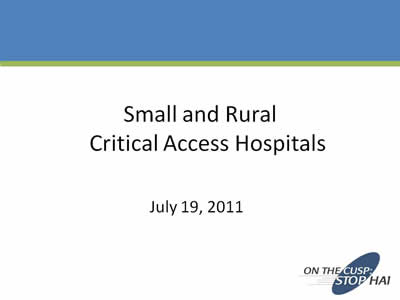
July 19, 2011
Slide 2. Agenda
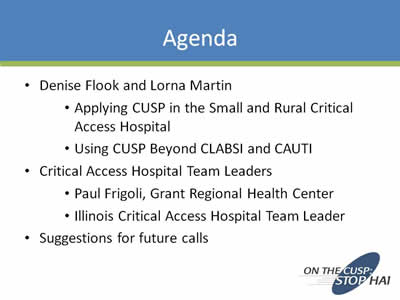
- Denise Flook and Lorna Martin
- Applying CUSP in the Small and Rural Critical Access Hospital
- Using CUSP Beyond CLABSI and CAUTI
- Critical Access Hospital Team Leaders
- Paul Frigoli, Grant Regional Health Center
- Illinois Critical Access Hospital Team Leader
- Suggestions for future calls
Slide 3. Applying CUSP in the Small and Rural Critical Access Hospital
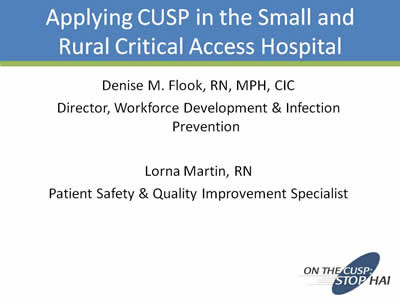
Denise M. Flook, RN, MPH, CIC
Director, Workforce Development & Infection Prevention
Lorna Martin, RN
Patient Safety & Quality Improvement Specialist
Slide 4. Quality and Safety and Now Key to Hospital Success
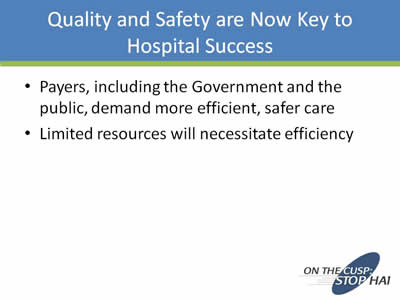
- Payers, including the Government and the public, demand more efficient, safer care
- Limited resources will necessitate efficiency
Slide 5. The Challenge
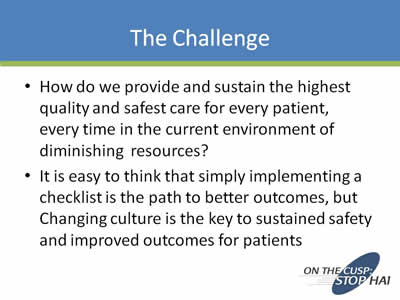
- How do we provide and sustain the highest quality and safest care for every patient, every time in the current environment of diminishing resources?
- It is easy to think that simply implementing a checklist is the path to better outcomes, but Changing culture is the key to sustained safety and improved outcomes for patients
Slide 6. Safety/Quality Improvement is a Two-Part Process
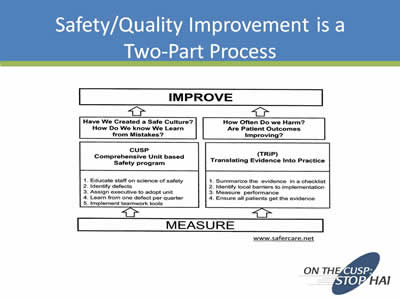
Image: Table showing Safety Quality/Improvement two-part process.
Top 2-Column Row: Improve
First Column:
Have we created a safe culture? How do we know we learn from mistakes?
CUSP Comprehensive Unit based Safety Program
- Educate staff on science of safety
- Identify defects
- Assign executive to adopt unit
- Learn from one defect per quarter
- Implement teamwork tools
Second Column:
How often do we harm? Are Patient outcomes improving?
(TRiP) Translating Evidence into Practice
- Summarize the evidence in a checklist
- Identify local barriers to implementation
- Measure Performance
- Ensure all patients get the evidence
Bottom 2-Column Row: Measure
Slide 7. What is CUSP?
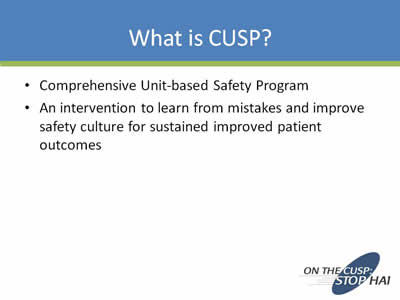
- Comprehensive Unit-based Safety Program
- An intervention to learn from mistakes and improve safety culture for sustained improved patient outcomes
Slide 8. On the CUSP: Process Intervention

Image of a flowchart. The intervention consists of two parts that you will pursue simultaneously. So while you are doing the work of reducing BSI, you will also be seeking to improve communication among care team members, finding ways to better coordinate care, improving overall patient safety on your unit and working toward a healthy and rewarding unit culture. Today’s presentation is about the left side of this graphic, the CUSP program, the purpose of which is to help you realize these goals, by tailoring its tools to your own unit and situation.
Slide 9. The CUSP Steps
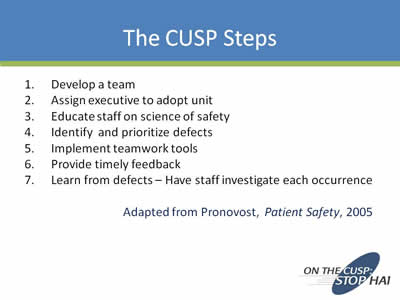
- Develop a team
- Assign executive to adopt unit
- Educate staff on science of safety
- Identify and prioritize defects
- Implement teamwork tools
- Provide timely feedback
- Learn from defects – Have staff investigate each occurrence
Adapted from Pronovost, Patient Safety, 2005
Slide 10. On The CUSP

Diagram reading from top to bottom:
Top Row: On the CUSP
Second Row: Assemble a CUSP team, Partner with a senior Executive; Baseline Data
Third Row: Technical Practices to Prevent Harm
Fourth Row: Evidence Based Practice
- Evaluation
- Systems Analysis
- Process Development
Quality Improvement Tools
- PDCA
- Lean/Six Sigma
- Reliable System Process
- TCAB
- Other
Education on the evidence
- Presentation of evidence
- Fact Sheet
- Cost Estimator
- Summary of Professional Organization Recommendations
- Annotated Bibliography
Fourth Row: Implementation/Sustaining
- Checklist
- Policy/Procedures
- Protocols
- Monitoring
- Feedback
Third Row: Adaptive (CUSP)
Fourth Row: Science of Safety
- Science of safety presentation
- Attendance sheet
Fourth Row: Staff Identify Defects
- Staff Safety Assessment form
- Identifying Hazards Presentation
Fourth Row: Senior Executive Partnership
- Education
- Briefings
Fourth Row: Learning from Defects
- LFD toolkit
- RCA of each incidence
Fourth Row: Implement Tools for Teamwork and communication
- Daily goals
- Shadowing
- AM Briefing
- Call list
- Team Check up tool
- Team STEPPS Tools
Slide 11. CUSP is a Continuous Effort
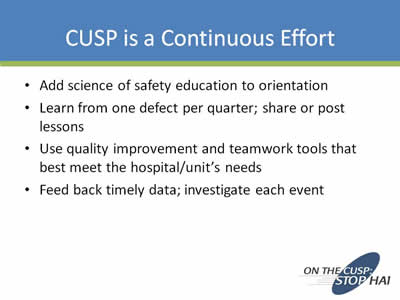
- Add science of safety education to orientation
- Learn from one defect per quarter; share or post lessons
- Use quality improvement and teamwork tools that best meet the hospital/unit’s needs
- Feed back timely data; investigate each event
Slide 12. Walking Through the Process
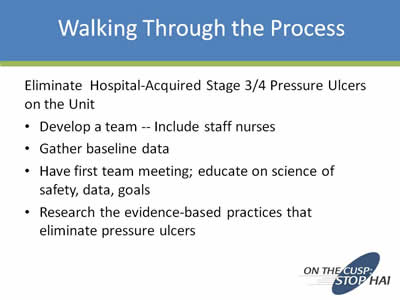
Eliminate Hospital-Acquired Stage 3/4 Pressure Ulcers on the Unit
- Develop a team -- Include staff nurses
- Gather baseline data
- Have first team meeting; educate on science of safety, data, goals
- Research the evidence-based practices that eliminate pressure ulcers
Slide 13. The CUSP/Improvement Intervention
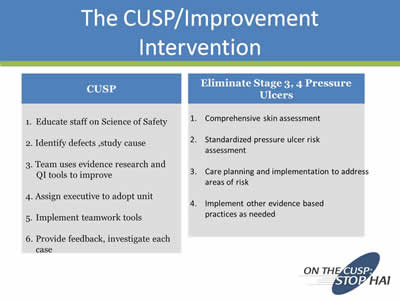
Two text boxes with the following information:
CUSP
- Educate staff on Science of Safety
- Identify defects, study cause
- Team uses evidence research and QI tools to improve
- Assign executive to adopt unit
- Implement teamwork tools
- Provide feedback, investigate each case
Eliminate Stage 3, 4 Pressure Ulcers
- Comprehensive skin assessment
- Standardized pressure ulcer risk assessment
- Care planning and implementation to address areas of risk
- Implement other evidence based practices as needed
Slide 14. On The CUSP
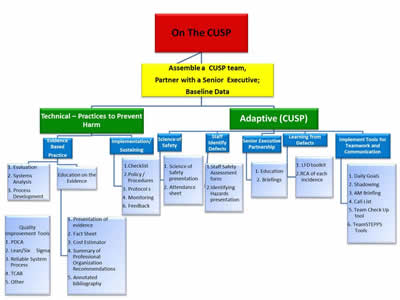
Identical diagram from Slide 10.
Slide 15. It Goes Back to Leadership - On All Levels
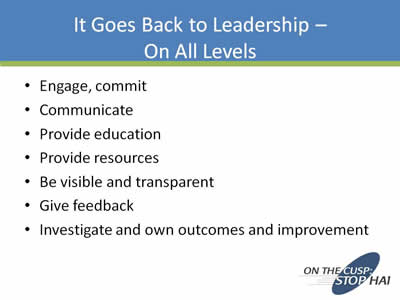
- Engage, commit
- Communicate
- Provide education
- Provide resources
- Be visible and transparent
- Give feedback
- Investigate and own outcomes and improvement
Slide 16. Keep the Focus
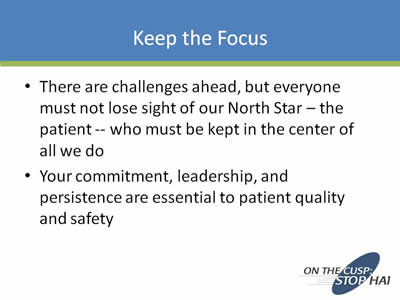
- There are challenges ahead, but everyone must not lose sight of our North Star – the patient -- who must be kept in the center of all we do
- Your commitment, leadership, and persistence are essential to patient quality and safety
Slide 17. References
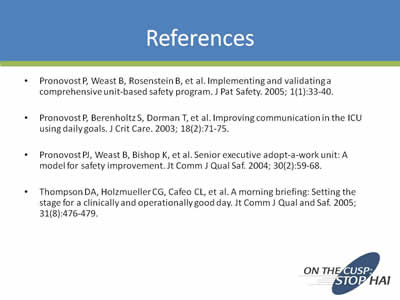
- Pronovost P, Weast B, Rosenstein B, et al. Implementing and validating a comprehensive unit-based safety program. J Pat Safety. 2005; 1(1):33-40.
- Pronovost P, Berenholtz S, Dorman T, et al. Improving communication in the ICU using daily goals. J Crit Care. 2003; 18(2):71-75.
- Pronovost PJ, Weast B, Bishop K, et al. Senior executive adopt-a-work unit: A model for safety improvement. Jt Comm J Qual Saf. 2004; 30(2):59-68.
- Thompson DA, Holzmueller CG, Cafeo CL, et al. A morning briefing: Setting the stage for a clinically and operationally good day. Jt Comm J Qual and Saf. 2005; 31(8):476-479.
Slide 18. Denise M. Flook
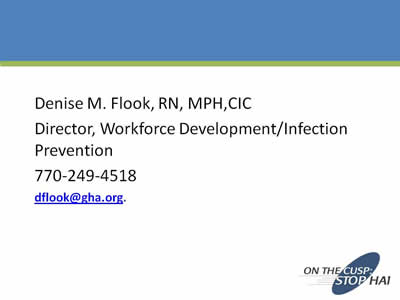
Denise M. Flook, RN, MPH,CIC
Director, Workforce Development/Infection Prevention
770-249-4518
Slide 19. CUSP Resources
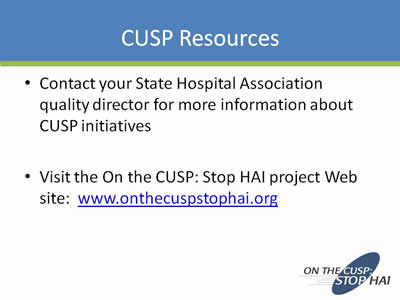
- Contact your State Hospital Association quality director for more information about CUSP initiatives
- Visit the On the CUSP: Stop HAI project Web site: www.onthecuspstophai.org
Slide 20. Hearing From Your Peers

Slide 21. Paul Frigoli
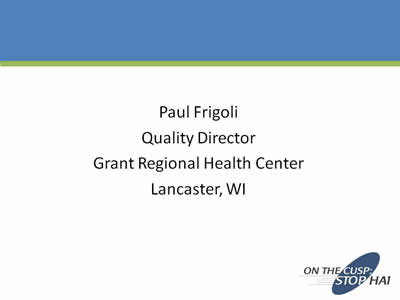
Paul Frigoli
Quality Director
Grant Regional Health Center
Lancaster, WI
Slide 22. Agenda
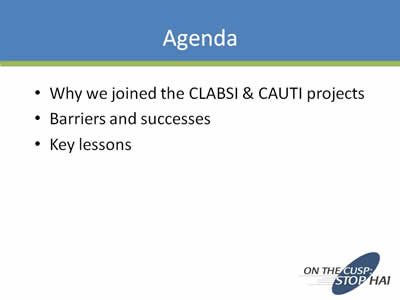
- Why we joined the CLABSI & CAUTI projects
- Barriers and successes
- Key lessons
Slide 23. Val Pfoutz
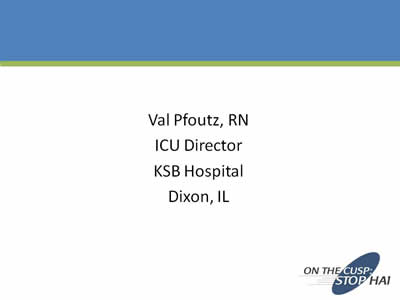
Val Pfoutz, RN
ICU Director
KSB Hospital
Dixon, IL
Slide 24. Agenda
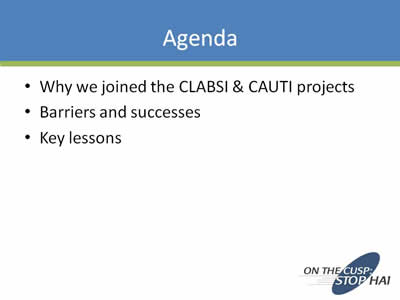
- Why we joined the CLABSI & CAUTI projects
- Barriers and successes
- Key lessons
Slide 25. CUSP Resources
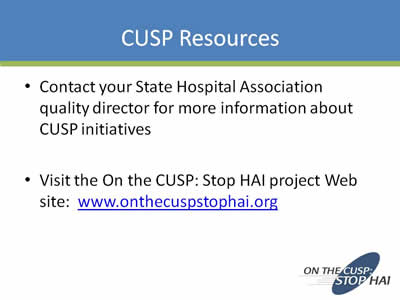
- Contact your State Hospital Association quality director for more information about CUSP initiatives
- Visit the On the CUSP: Stop HAI project Web site: www.onthecuspstophai.org
Slide 26. Hearing From You
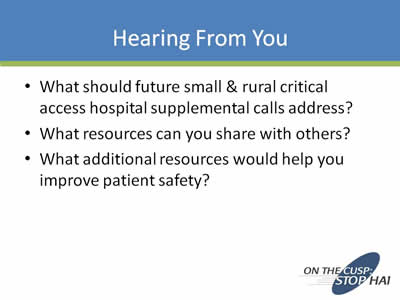
- What should future small & rural critical access hospital supplemental calls address?
- What resources can you share with others?
- What additional resources would help you improve patient safety?



